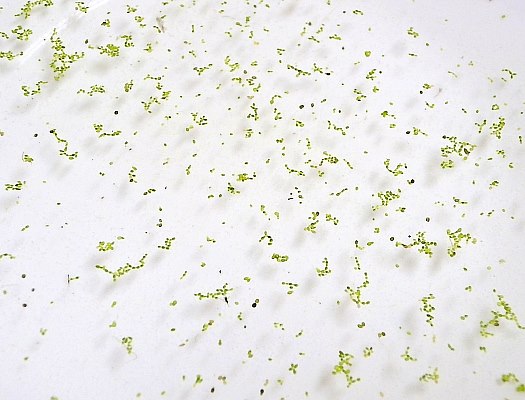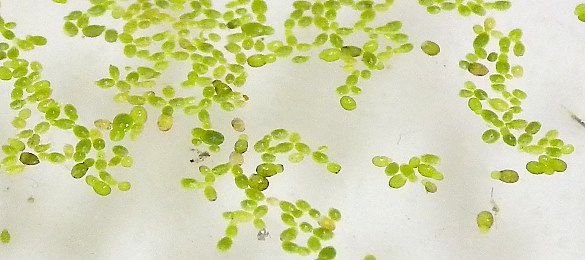
Flowers are rarely produced. On the rare occasions when a frond is in bloom, it produces a single minute flower within a floral pouch on the upper surface. This flower consists of a single anther and a single bottle-shaped pistil; there are neither petals nor sepals. Flowers usually bloom from late summer into early fall. Afterwards, each flower is replaced by a single achene that is smooth and up to 0.5 mm. in length. Aside from this method, reproduction almost always occurs by budding (the cloning of a daughter frond). The daughter frond emerges from a budding pouch that is located at the side of one end of the mother frond. Quite often, the daughter frond and mother frond remain attached to each other for a period of time before they separate. While it is in the attached condition, the daughter frond is smaller in size than the mother frond. During the fall as cold weather arrives, the mother frond will produce a special daughter frond that is called a 'winter turion.' This turion is filled with starch and it sinks to the bottom of the body of water to survive the winter. Fronds never produce roots. Correct identification of Watermeal species (Wolffia spp.) requires at least 10x magnification.
Cultivation: The preference is clear stagnant water that is protected from the wind. The water should be pH 6.0 and above. Most growth and reproductive activity occurs when the weather and water temperature are warm during the summer and early fall; abundant nutrients (e.g., nitrogen & phosphorus) in the water also encourage growth and reproductive activity. Access to light (full sun to light shade) is also required.
Range & Habitat: The native Brazilian Watermeal occurs in scattered areas of Illinois, where it is uncommon. Because of the inconspicuous nature of this plant and the difficulties of identification, it is probably more common than current records indicate. This species has a relatively wide distribution in both North America and South America. Habitats include small ponds (especially in wooded areas), limestone sinkholes, shrub swamps, and sandy swamps. Buttonbush (Cephalanthus occidentalis) is often present in the swampy areas where Brazilian Watermeal occurs. In addition, other species of watermeal (Wolffia spp.) and duckweed (Lemna spp.) are often present in these habitats.
Faunal Associations: Some insects that feed on duckweed (Lemna spp.) may also feed on watermeal (Wolffia spp.), as these two genera are closely related (see Lemna minor for a listing of these species). Among vertebrate animals, there is some evidence that ducklings (those of the Wood Duck) feed on watermeal, as do the Snapping Turtle (Chelydra serpentina) and the Slider (Trachemys scripta). Watermeal is an important source of food for many fish species (particularly fingerlings) in wetland habitats, and it is also used in fish farms and to feed fish in aquariums. As a food source, watermeal is an excellent source of both protein and starch. However, if watermeal is allowed to completely cover the surface of a body of water as a result of excessive fertilization, it may deplete oxygen levels and kill fish. Watermeal also provides habitat for many aquatic invertebrates.
Photographic Location: A sandy swamp in Vermilion County, Illinois.

Comments: From a distance, an abundance of watermeal (Wolffia) looks like green pond scum or algae, but a closer examination will reveal its distinctive mealy texture. Watermeal is the smallest flowering plant in the world – even smaller than the closely related duckweed (Lemna). In addition to its smaller size, watermeal can be distinguish from duckweed by its absence of roots. In contrast, each frond of duckweed has a single root extending into the water. In Illinois, there are 3 species of watermeal: Brazilian Watermeal (Wolffia brasiliensis), Northern Watermeal (Wolffia borealis), and Common Watermeal (Wolffia columbiana). Brazilian Watermeal can be distinguished from Northern Watermeal by its broader shape (1.0-1.5 times as long as it is across) and the conical bump (papule) on its upper surface. Northern Watermeal is 1.5-2.0 times as long as it is across, its upper surface is flat, and one end of its frond is acute (tapers to a point), rather than rounded. Common Watermeal differs from the preceding species by its convex upper surface and its frond is light green throughout, rather than bicolored (medium to dark green above, light green to transparent below). In addition, dried herbarium specimens of Common Watermeal lack the brown dots of pigment cells that can be found in the dried herbarium specimens of the preceding two species. A scientific synonym of Brazilian Watermeal is Wolffia papulifera.